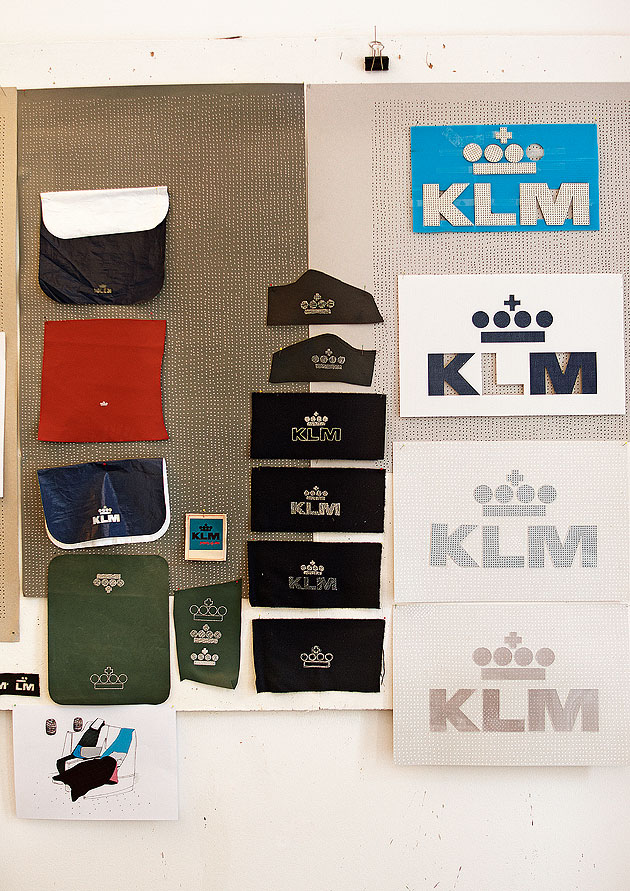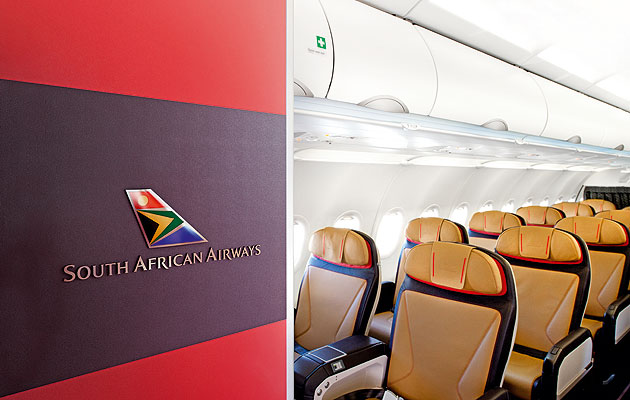|
It’s not often in life we choose to put ourselves completely in the hands of another’s design. But we do it every time we step aboard an aeroplane. With a wave of the boarding pass and a smile to the stewardess, we submit ourselves – body and soul – to a brand whose service and safety we must trust. With our own belongings surrendered to the hold, the food, comfort and entertainment of the immediate future is wholly in the charge of the airline we are flying with. Up in the air, however, the brand experience that’s so replete in logo and literature often stops short of the cabin interior. Standardisation is the default of the aviation industry, due to complicated safety standards and a small pool of specialised manufacturers. When Hella Jongerius studied the situation for KLM, she saw an opportunity to introduce some individuality, as well as a designer’s touch, to cabin life. Her interior for the Dutch national carrier’s World Business Class is based on the idea that flight can be personal, relaxing and altogether more human. Renowned for her textile designs and mastery of colour, Jongerius’ starting point was to improve the seat upholstery. Edith van Berkel, a senior designer at Jongeriuslab, explains: “KLM is the oldest airline in operation, and the first to own a colour: this very typical sky-blue. It’s a good, strong colour but in the existing cabin there were so many mismatching types of it. It had a different appearance on each material.” The problem was a case of too many hands. In aviation design, many manufacturers each take a small part of the final construction, working to standard fixings provided by Boeing or Airbus, but never overseen by one creative guide.
|
Words Riya Patel
Image Marcus Gaab |
|
|
||
 |
||
| The solution was to create an arrangement of colours that would complement the KLM blue, enhancing it rather than creating conflict. Five wool seat cover designs were developed in aubergine, dark brown, night blue, cobalt and dark grey, with the idea of spreading the different colour ways randomly throughout the cabin for a more varied and rich environment. It was a proposal that caused KLM a logistics headache, but ultimately won through. “It’s great that we were allowed to do that,” says van Berkel. “It had a big impact on cleaning and other processes. But we felt it would provide a more homely environment, and express the idea that everyone can have an individual seat.” In a further attempt to add a shade of personality to an environment usually overegged with corporate gloss, Jongerius boldly removed the letters KLM from the logo on the seat headrests – leaving just the inimitable formation of cross, line and circles that refer to the Dutch crown.
Circles appear in many of the patterned elements designed by Jongerius. The class divider is decorated with dotted chains that are supposed to represent a bead curtain. The aim was to make us think of transparency, but the nod to flight’s retro heyday can’t be ignored. The carpet was also borne of a spark of inspiration from the past. Van Berkel read that in 2010, when fashion designer Mart Visser redesigned the KLM cabin crew uniforms, the obsolete stock was shredded and has since been lying in a hangar. Working with Dutch carpet company Desso, known for its cradle-to-cradle approach, Jongeriuslab worked the wool uniforms into the weave of the new carpet as random dots of sky blue. “It was already the perfect blue, and 100 per cent wool, so a really nice material. It also meant we were able to make the carpet a little lighter, something that’s so important in designing for airlines.” |
||
 |
||
| Jongeriuslab was keen to be involved in the design of the World Business Class seat, too – a field mostly dominated by engineers and aviation designers. “We asked to look at the seat, because we thought it was somewhere to really add value,” says senior designer Arian Brekveld. After taking delivery of a new aircraft, airlines generally choose seat products “off the shelf” and opt to customise them to a degree. Jongeriuslab’s changes to the Diamond, a fully flat model by BE Aerospace, involved creating a softer, more visually pleasing shape, and changing materials to resonate with the rest of the cabin interior. “Something really unique is that the outer shell of the seat is a different colour to the inner,” Brekveld explains. “So as the passenger reclines, he sees this canopy of sky blue.”
Not all airlines will give an external designer such a degree of freedom. And not all passengers will place such value on an environment they spend only a certain amount of time in. But KLM’s advantage is that it is the carrier of a nation where design is part of the DNA, a nation known for its strength in creative risk-taking and individuality. During her research, Jongerius found drawings made for KLM in the 1950s by Gerrit Rietveld, whose redesign also proposed a variety of interior colours but must have been too radical for the time. More recently, Marcel Wanders was invited on board to refresh the dinner service in typically flamboyant style (Icon 091), and in 2011, Amsterdam-based fashion house Viktor and Rolf was asked to create luxurious passenger amenity kits for business class (also to be found on eBay if you want a taste of the high life). Where design isn’t already part of the picture, creating a strong visual identity around a national carrier can be more like branding an entire country. This was the task South African Airways put to Priestman Goode, a London-based firm with expertise in aviation design. Director Luke Hawes says: “SAA wanted to represent a continent as well as a nation. And they hadn’t really used designers throughout their history, always going to manufacturers first.” The project started with a trip to absorb South African culture through fashion, architecture, furniture and craft. Working with a local agency, an artwork was put together based on the colours of the airline’s livery and it was from this that the palette for the interior was drawn. “We chose gold and anthracite, natural warm colours, with hints of brighter tones,” says Hawes. Working within financial and time constraints, the firm sought to customise standard elements where possible; introducing branding patterns on seat reveals, adding red stitching to the backrest and creating bespoke attachments such as an acid-etched magazine rack. These small details lift the design from disappearing into the standard aircraft background. Having worked on projects for many airlines including Lufthansa, Turkish Airlines and Thai Airways, Priestman Goode is used to dealing with the cultural sensitivities of boiling a national attitude down to a brand. A local representative is involved at stages through the project to make sure signs and symbols don’t get lost in translation, or worse, cause offence. We’ve all seen the uproar when a much-loved logo is updated, and the sensitivity is particularly heightened when there is national pride at stake. To mark the merger of US Airways and American Airlines, FutureBrand designed a refreshed version of the AA logo after Massimo Vignelli’s version stayed more or less unchanged for 40 years. Sixty-thousand AA staff voted in the new logo – a composite of an eagle, the red, white and blue flag, an “A” and a star (all pinnacles of American-ness) – but one critic wasn’t happy with the change: Vignelli. In his opinion, the original was timeless, the strength of a logo being in its ability to endure. Kari Blanchard, executive director at FutureBrand, says: “The past identity was associated with a post Second World War America. Stars, stripes and an eagle in attack-mode represented America’s militaristic power. Today, people see America differently, so in updating the identity we focused on capturing the spirit of America, and not its might.” But is branding really capable of representing a national identity? And does it gain an airline any advantage in a competitive marketplace? “Most airlines have the challenge of being both global and national – almost all aim to blend the two, but with varying ratios,” says John Tighe, design director of James Park Associates. JPA is a London-based firm designing for both the revamped AA and the Next Generation business class cabin for Singapore Airlines. “For Singapore, it isn’t about overtly branded spaces, it’s about getting the right ambience.” Design considerations are focused on mixing traditional hospitality with the latest technology. Like futuristic cocoons, the seats offer the ultimate in privacy, luxury and attention to detail. Tighe says: “Often a design will show you all it has within the first few seconds, yet the flights can be often over ten hours. Our approach ensures you are still noticing new details after several hours.” Design may never come above safety, cost or reliability when it comes to choosing an airline. But there are signs that it is giving some companies the edge in the battle for our business. “When Virgin Atlantic and British Airways were racing to create the first fully flat bed … that’s when design really became a way to differentiate yourself,” says Hawes. Now that all airlines can offer a similar technical level of comfort, it’s the details that will keep them competitive. Brekveld says: “You can really make a difference with the atmosphere and the tactility. You can really try to make passengers feel relaxed, and not feel like they are in yet another office. Good design is a way to give them something extra.” |
||



















